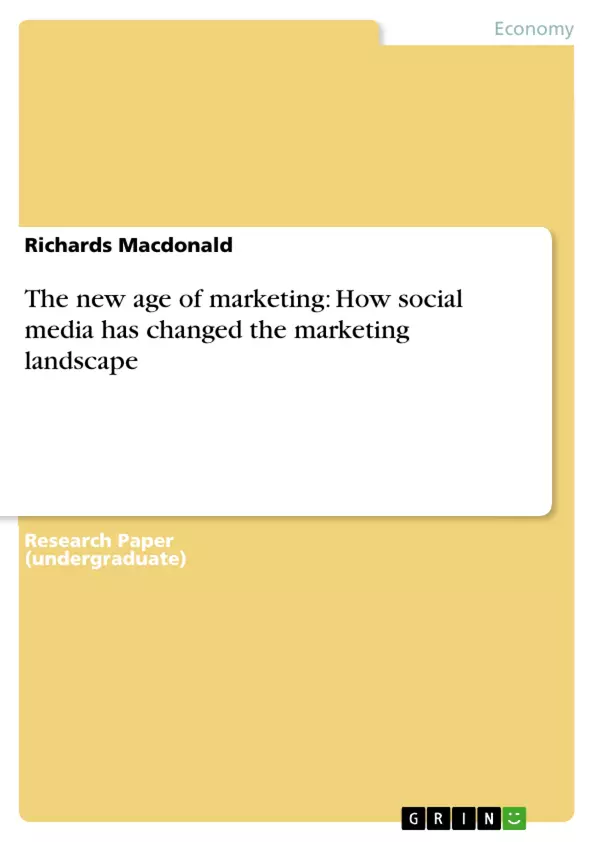The social media marketing has affected the landscape of the conventional marketing substantially and the frameworks and the methodologies of conventional marketing has also been affected significantly with the increase in popularity and influence of the social media marketing. The paper provides background information on the subject under research, including appropriate concepts, theories, ongoing debates and issues and the statement of the problem, the research questions and the appropriate hypothesis. The objectives of this dissertation are to illustrate the changes made by the social media marketing on conventional marketing landscape and its frameworks and methodologies. It also compares and contrasts the social media marketing and conventional marketing. The changes made by social media marketing on the current marketing landscape are demonstrated by analyzing current case studies. The dissertation also includes the analysis and recommendations of the ways which might lead to replacement of the conventional marketing methodologies by social media marketing methodologies in future.
A detailed description of social media marketing and conventional marketing is provided in the first section of this dissertation which includes the characteristics, key features, nature, scope, etc. of both social media marketing and conventional marketing. This section also provides the description of the areas to be covered in this paper such as the explanation of the relevant concepts, theories, etc. The next section of the paper provides the methods and techniques used in this dissertation and it also justifies the selection of the investigative method(s) and data-gathering technique(s) used for the investigation of the topic. It also makes appropriate referring to research methods textbooks and literature. The literary review section of the dissertation provides the critical analysis of the relevance and utility of materials relevant to the chosen topic. It includes a wide range of books, articles, journals, literature available on the topic written by different established author in the field. Though social media marketing is a new concept there is no dearth of good literature and research works in the field. This section of the dissertation provides a critical analysis of the literature on the topic under consideration identifying key issues and they are organised into themes on the topic of the research.
Inhaltsverzeichnis (Table of Contents)
- Chapter 1- Introduction
- 1.1. Aim and Objectives
- 1.2. Social networking websites and blogs.
- 1.2.1. Social networking websites and Blogs.
- 1.2.2. Cell phones.....
- 1.2.3. Engagement
- Chapter 2 - Literature Review
- 2.1 Social Media Marketing: Concepts
- 2.2 Social Media Marketing: Types.
- 2.3 Social Media Marketing: Advantages and Disadvantages
- 2.4 Metrics of Social Media Marketing.
- 2.5 Impact of Social Media Marketing.
- 2.6 Future of Social Media Marketing
- Chapter 3 - Methodology.
- 3.1 Purpose of Research
- 3.2 Research Design.
- 3.3 Procedure........
- 3.4 Methods.....
- 3.5 Reliability.
- 3.6 Limitation
- Chapter 4 Findings: Results, Analysis and Discussion
- 4.1 Social Media Marketing and Conventional Marketing
- 4.2 Social Media Marketing and Integrated Marketing Communications…....
- 4.3 Impact of Social Media Marketing to Consumers..\li>
- 4.4 Social Media Marketing Options for Marketers
- 4.5 Advancement in Social Media Marketing.
Zielsetzung und Themenschwerpunkte (Objectives and Key Themes)
This research aims to investigate the impact of social media marketing on the conventional marketing landscape, examining how it has changed existing frameworks and methodologies. The research will cover key areas including the critical review of social media marketing literature, a comparative analysis of social media and conventional marketing, the demonstration of social media marketing’s impact on the current marketing landscape through case studies, and recommendations for the potential replacement of conventional marketing methodologies by social media marketing approaches in the future.
- The evolution and influence of social media marketing.
- Comparative analysis of social media marketing and conventional marketing.
- The impact of social media marketing on consumers and businesses.
- The potential for social media marketing to replace traditional marketing methods.
- The future trends and advancements in social media marketing.
Zusammenfassung der Kapitel (Chapter Summaries)
Chapter 1 provides a comprehensive introduction to the topic of social media marketing, discussing its emergence, growth, and influence on conventional marketing practices. This chapter also outlines the objectives and scope of the research. Chapter 2 presents a thorough literature review, delving into the concepts, types, advantages, and disadvantages of social media marketing. The chapter also explores key metrics and the broader impact of social media marketing, looking ahead to its future direction. Chapter 3 focuses on the research methodology employed in the study, detailing the research design, procedures, methods, reliability, and limitations. Chapter 4 presents the findings of the research, analyzing and discussing the relationship between social media marketing and conventional marketing, examining its impact on consumers, and exploring the options and advancements available to marketers.
Schlüsselwörter (Keywords)
The study focuses on the key concepts of social media marketing, conventional marketing, integrated marketing communications, consumer behavior, marketing strategies, and digital marketing trends. The research also examines the impact of social media platforms, online engagement, and the role of social media in shaping the future of marketing.
- Quote paper
- Richards Macdonald (Author), 2012, The new age of marketing: How social media has changed the marketing landscape, Munich, GRIN Verlag, https://www.grin.com/document/213349



